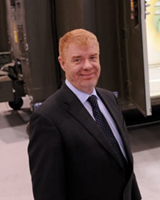Marshall

About: Ray Cutting - Managing Director
Ray joined Marshall from British Aerospace (Dynamics) having started as a graduate engineer before moving into Project Management. He has undertaken several roles within Marshall as Project Manager, Engineering Manager, Engineering Director, and Managing Director of Marshall Specialist Vehicles. His development within positions at Marshall has led him to his current role as Managing Director of Aerostructures and Land Systems where he heads up an agile and innovative team providing solutions for the armed forces and defence industry.
1. How has Marshall sought to meet this important part of the covenant between a population and its military?
A: Marshall and its partners can provide air, sea and land solutions to treat casualties from the front line through the care pathway to a home based hospital. From specialist IV fluid systems preventing hypothermia to stretcher systems to military treatment facilities, including arguable the world’s most advanced deployable trauma hospital -to aero medevac solutions which are designed to maximise the utilisation of aircraft.
2. How do you do this?
A: We work closely in partnership with our customers and suppliers to define the requirement and prove the design before manufacturing it and subsequently providing through life support which can include contracting for availability.
3. What sorts of medical facilities can you provide?
A: Our deployable medical treatment facilities can be either hard or soft skinned. Ambulance stretcher systems are designed for both armoured and high mobility vehicles. Our purpose designed air evacuation solutions enable very rapid re-rolling of an aircraft.
We have proven experience of housing complex medical equipment in shelters, and our work on deployable CT Scanners has been recognised by the award of a Queen’s Award for Innovation.
4. Could you give an example of your approach to international partnerships?
In Norway we have developed the Marshall Export Development Programme (MEDP), a network of companies all of whom are leaders in their own specialist areas of military medicine.
5. Can you tell us about the networks’ defence medical capabilities?
A: Nodin Aviation and Marshall have a pedigree of providing air evacuation solutions and together we have the ability to re-role aircraft for this specialist task. We can also provide containerised medevac systems which can be carried in a number of aircraft such as C-130s and incorporate a full suite of specialist medical equipment to move critically injured or ill patients back to their national hospitals. Nodin’s skills include shock and vibration damped stretcher systems for land, air and naval casualty evacuation.
Marshall has provided shelter based facilities and most recently a chemical and biological protected tent based hospital to the UK MOD. Norlense offers tented field hospital solutions which can be deployed worldwide. The high pressure beams allow for better space, lower weight and ease of use.
At the beginning of the care pathway one of the critical elements is getting fluids into a casualty. Our partner MRE offers a system, in service with Norwegian Special Forces, which warms the liquid before it is injected into the patient and hence reduces the risk of hypothermia, a major problem in both cold and warm temperatures where a cold infusion can cause shock.
It is vital to extract the casualty quickly from the battlefield. High off road mobility is often key. Arctic Trucks gained fame through the BBC programme Top Gear by driving a high mobility Toyota to the North Pole. Based on such technology the MEDP companies can offer high mobility ambulances to get patients away from the danger zone and save lives.
Merlin and Marshall are working together to develop a rugged and flexible surgical light system for austere environments. Berget provides high precision components for medical and defence equipment. Their AS 9100 certification ensures high quality parts for aerospace as well.
6. What hopes do you have for the future?
Our solutions are being proposed for customers throughout NATO, the Middle East, Asia, the Americas and with many of the world’s leading defence prime contractors.
7. How would you summarise all this?
Together this team has the ability to provide support across the medical care pathway. It is very much a case of the sum of the whole being greater than the sum of the parts.
Our solutions are proven and in service with defence worldwide.

Marshall has been awarded a Queen’s Award for Innovation because of its work in developing a deployable SCT Scanner in partnership with Philips Healthcare. The scanner can be providing diagnostic imagery within four hours of arriving on scene.

Marshall has recently supplied a Chemical and Biological protected hospital to the British Army, seen here deployed on field acceptance trials.

AFV stretcher solutions can be provided by Marshall in partnership with Nodin

Together Marshall and Nodin have developed the ability to re-role an aircraft for medevac in around 4 hours.

MRE’s infusion kit plays a significant role in reducing shock on the battlefield by warming the liquid to body temperature.

Marshall supplied three container based hospitals to the NORWEGIAN armed Forces. These have seen service in Chad in support of a UN deployment as well as providing an alternative treatment facility whilst Bergen hospital was being renovated.


